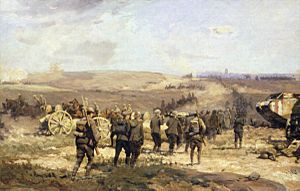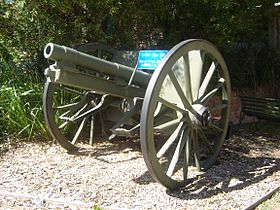Battle of Amiens (1918) facts for kids
Quick facts for kids Battle of Amiens |
|||||||
|---|---|---|---|---|---|---|---|
| Part of the Western Front of World War I | |||||||
 8 August 1918 by Will Longstaff, showing German prisoners of war being led towards Amiens |
|||||||
|
|||||||
| Belligerents | |||||||
|
|
|||||||
| Commanders and leaders | |||||||
|
|
||||||
| Strength | |||||||
| 19 British Empire divisions (10 British, 5 Australian, 4 Canadian) 12 French divisions 1 American division 1,104 French aircraft 800 British aircraft 532 tanks |
10 active divisions 4 reserve divisions 365 aircraft |
||||||
| Casualties and losses | |||||||
| 44,000 (22,000 British Empire, 22,000 French) | 75,000 (50,000 prisoners) | ||||||
The Battle of Amiens was a very important battle during World War I. It began on August 8, 1918. This battle was the start of the Hundred Days Offensive, which eventually led to the end of the war.
On the first day, the Allied forces, including British, Australian, and Canadian troops, pushed forward more than 11 kilometers (about 7 miles). This was one of the biggest advances of the entire war. General Henry Rawlinson's British Fourth Army played a key role. The battle was also special because it showed how much the soldiers' spirits changed. Many German soldiers gave up, which made German General Erich Ludendorff call the first day "the black day of the German Army". Amiens was also one of the first big battles where tanks were used a lot.
Contents
Why the Battle Happened
In March 1918, the German Army launched a series of big attacks called the Spring Offensive. They wanted to push the Allies back on the Western Front. Germany had moved many soldiers from the Eastern Front after signing a peace treaty with Russia. This gave them a temporary advantage.
One of these German attacks, called Operation Michael, tried to defeat the British army. They aimed for the town of Amiens, which was a very important railway hub. But British and Australian troops stopped their advance near Villers-Bretonneux on April 4.
Other German attacks also happened, but none of them achieved a final victory. By July, the German army was tired, and their supplies were running low. The Allied commander, General Ferdinand Foch, ordered a counter-attack. This led to a victory at the Second Battle of the Marne. After this, Foch decided it was time for the Allies to go on the attack.
Planning the Attack
General Foch shared his plan on July 23. He wanted to clear out a German-held area called the Saint-Mihiel salient. He also wanted to free up the railway lines around Amiens from German shelling.
The British commander, Field Marshal Sir Douglas Haig, already had plans for an attack near Amiens. General Henry Rawlinson's British Fourth Army was in charge of the front line there. The Australian Corps and Canadian Corps were known for their strong and new fighting methods.
Rawlinson and the Australian commander, John Monash, suggested their plan to Haig. Haig then sent it to Foch. On July 24, Foch agreed, but he wanted the French First Army to join in. Rawlinson was worried because his plan relied on using many tanks to surprise the Germans. The French army didn't have many tanks, so they would have to fire their cannons first, which would warn the Germans.
They finally agreed that the French would attack 45 minutes after the British. This way, the surprise would still be mostly there. They also decided to attack on August 8 instead of August 10. This was to hit the Germans before they could fully retreat from another area.
Secret Preparations
A key part of the plan was keeping it a secret. Unlike usual, there would be no long cannon bombardment before the attack. The cannons would only fire right when the soldiers and tanks moved forward. This was meant to shock the Germans.
The Fourth Army had a huge number of cannons: 1,386 field guns and 684 heavy guns. Major General Charles Budworth planned the artillery fire. New British technology helped them aim the cannons very accurately without warning shots. This meant 504 out of 530 German cannons could be hit right at the start of the attack.
There were also 580 tanks ready. The Canadian and Australian forces each got many tanks, including 108 Mark V fighting tanks. Some tanks were even designed to carry supplies.
The Allies managed to move the entire Canadian Corps to Amiens without the Germans finding out. This was a great achievement. To keep the secret, soldiers were told to "Keep Your Mouth Shut," and the attack was called a "raid" instead of a full "offensive."
German Expectations
Even though the Germans were still attacking in late July, the Allied armies were getting stronger. More American soldiers arrived, and British troops came from other areas. German commanders realized they might have to defend soon. However, they didn't think Amiens would be the main attack point. They thought the French would attack near Reims and the British near Lys or Albert.
The Allies made sure to keep firing cannons and flying planes evenly across all their fronts. They moved troops only at night and pretended to move them during the day. This helped hide their real plans for Amiens.
On August 6, the Germans actually attacked a small part of the front north of the Somme River. This was where the Allies planned to attack two days later. The German attack was a response to an Australian raid. This small German move meant the Allies had to make some last-minute changes to their plan.
To make the surprise even bigger, bombers were supposed to fly over the German lines. Their loud engines would hide the sound of the approaching tanks. Even though there was thick fog, two brave pilots volunteered to fly, earning medals for their courage.
The Battle Begins
First Day: A Huge Surprise
The battle started in a thick fog at 4:20 AM on August 8. The British III Corps attacked north of the Somme River. The Australian Corps attacked south of the river, and the Canadian Corps attacked even further south. The French First Army started its cannon fire at the same time and began its advance 45 minutes later.
The attack was so unexpected that the German forces didn't even fire back for five minutes. Even then, they fired at empty positions where the Allies had been moments before.
Seven Allied divisions attacked in the first wave. They quickly captured the first German positions, moving about 3.7 kilometers (2.3 miles) by 7:30 AM. The Australian and Canadian forces, in the center, moved very fast. They pushed the front line 4.8 kilometers (3 miles) forward by 11:00 AM. They moved so quickly that they captured German officers and staff while they were eating breakfast!
By the end of the day, a 24-kilometer (15-mile) gap was made in the German line south of the Somme. North of the river, the British III Corps had less success because the land was rougher and they had fewer tanks.
The British Fourth Army captured 13,000 German prisoners, and the French captured another 3,000. It's thought that the Germans lost 30,000 soldiers on August 8 alone. The Allies had about 8,000 casualties.
German Army Chief of Staff Paul von Hindenburg noted that the Allies used surprise very well. German General Erich Ludendorff called August 8 "the black day of the German Army." This wasn't just because of the land lost, but because the German soldiers' spirits had dropped so low. Many soldiers began to surrender. Some retreating troops even shouted at their officers, "You're making the war last longer!"
By the end of the day, Allied forces had pushed, on average, 11 kilometers (7 miles) into German territory. The Canadians gained 13 kilometers (8 miles), Australians 11 kilometers (7 miles), the French 8 kilometers (5 miles), and the British 3.2 kilometers (2 miles).
Second Phase: Continuing the Push
The advance continued on August 9, but it wasn't as fast as the first day. The battle spread out to the north and south. The southern part, involving French forces, was called the Battle of Montdidier.
The soldiers had moved faster than their supporting cannons. Also, the number of tanks ready for battle dropped from over 500 to just six within four days. Roads were jammed, making it hard to bring up new troops and supplies quickly.
A key German position called the Chipilly Spur was still held by the Germans. From this ridge, they fired machine guns and cannons, stopping the Australian Corps across the river. American soldiers from the 33rd U.S. Infantry Division were given the job of taking Chipilly Ridge.
By August 10, there were signs that the Germans were pulling back from the area they had gained in their Spring Offensive. By August 27, the Allies had captured nearly 50,000 prisoners and 500 cannons. Even with fewer tanks, the British pushed 19 kilometers (12 miles) into German positions by August 13.
Field Marshal Haig decided not to continue this attack. Instead, he wanted to start a new offensive in a different area.
What Happened After the Battle
The Battle of Amiens was a major turning point in World War I. Before this, the war on the Western Front had mostly been about trench warfare. The German Spring Offensive earlier in 1918 had given Germany an advantage again. But at Amiens, the use of tanks helped the Allies break through the strong trench lines. This showed that the old trench positions were no longer unbeatable. The British Third Army, which didn't have tank support, made almost no progress. But the Fourth Army, with its tanks, broke deep into German land.
Decorations
- Corporal Jake Allex of the 33rd U.S. Infantry Division received the Medal of Honor for his brave actions during the capture of Chipilly Ridge.
Images for kids
-
A crowd of German prisoners taken by the British Fourth Army in the Battle of Amiens, near Abbeville
See also
 In Spanish: Batalla de Amiens (1918) para niños
In Spanish: Batalla de Amiens (1918) para niños









